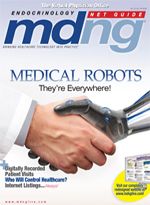Publication
Article
MDNG Endocrinology
TechSectors: The Benefits of Next-Generation Healthcare Connectivity
Healthcare is undergoing a transformation that is placing more responsibility and decision-making in the hands of patients. In this new healthcare world, physicians need tools that improve the...
Healthcare is undergoing a transformation that is placing more responsibility and decision-making in the hands of patients. In this new healthcare world, physicians need tools that improve the patient experience and office efficiency. These tools make communicating with a doctor as easy as sending an e—mail; enable test results to be available almost instantly; and eliminate redundant paperwork through secure electronic sharing. The solutions needed are readily available, cost-effective, and easy-to-use, allowing anyone with an e–mail address and Internet access to participate.
Secure Connectivity Tools Improve Patient Service
Connectivity tools allow medical providers to improve the patient-provider relationship by giving patients timely access to practice services. These tools, including secure messaging, patient portals, and document management solutions, allow patients to avoid redundant paperwork and build stronger bonds with their physicians, while maintaining the strictest levels of privacy.
As connectivity tools are adopted, patient expectations are changing. Dr. Tom Landholt of PatientCare Family Practice in Springfield, MO and Medical Director of HIT for MassPro, one of the leading performance improvement organizations in the United States, sends 70 percent of his lab results via secure messaging. Under the old workflow, patients would not be notifi ed for days. Now, his patients expect to have the results available to them the day after they are tested.
Connectivity solutions also increase information accuracy and replace the waiting room experience with convenient online services. Brian Williams, president of Springfield Neurological and Spine Institute in Missouri, is experiencing firsthand the growing confidence patients have in securely sharing health information online. When given the choice of paper forms or completing forms online, 50 percent of his patients elect to provide their information
online before arriving for their appointment.
Reducing Costs by Improving Office Efficiency
Improving the patient—doctor relationship through connectivity tools also improves the operational efficiency of the office. These tools enable doctors’ offices to overcome the inefficient manual processes associated with managing traditional mailings and faxes. At Westchester Medical Group, a multi-specialty practice based in White Plains, NY, 20 percent of each medical assistant’s time has been saved by implementing secure messaging to replace slow and error-prone phone and paper-based processes. The practice anticipates reducing costs an additional 30 percent over five years, as further improvements in productivity are realized through the implementation of more online services.
Many practices are building their entire organizations around this new way of doing business. Dr. Christopher Crow and his colleagues at Dallas-based Village Health Partners, the 2007 HIMSS Ambulatory Davies Award winner, believe connectivity solutions are central to providing exceptional levels of service to their patients. These tools place their practice on the cutting edge of innovation and are allowing the practice to expand its off erings in a brand new facility wired specifically for a paperless practice.
Patients of GreenField Health in Portland, OR, experience a clinical relationship fundamentally different from the typical practice experience. There is no waiting room at GreenField because patients never have to wait for their appointments. Every patient has their physician’s e—mail address and is invited to contact them with questions. These revolutionary changes are largely possible because GreenField has embraced modern information technologies, such as secure messaging and a patient portal, to facilitate more efficient and effective care.
As healthcare transforms, new competitors, including retail clinics and consumer companies, are altering patient expectations. These players understand the importance of connectivity. For example, the launch of Microsoft’s HealthVault platform prominently featured patient—physician communication. To succeed, providers must adopt solutions that dramatically improve the availability and efficiency of service and care, and ultimately democratize the healthcare system.
Luis Machuca is President and CEO of Kryptiq Corporation, the leading provider of next generation healthcare connectivity solutions.





